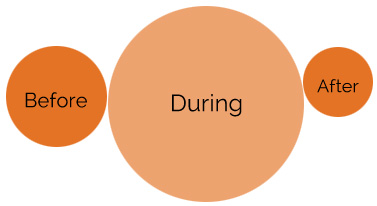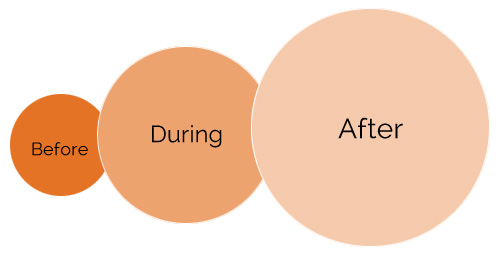Turn your event into an interest group
As every event sponsor knows, a meeting’s effectiveness depends significantly on how well the meeting’s sponsor follows up with attendees. In the old days, maybe that meant sending attendees a binder of session summaries and transcripts. Circa 1990, we started emailing PowerPoint presentations instead.
In today’s totally connected world, meeting PPTs and videos can live on your website. That’s all fine and good, but the downside is you don’t get to interact with the content consumers – other than perhaps tracking their page views or barraging them with phone calls and emails.
Too many of us, I think, fall into the trap of giving short shrift to post-event strategies to improve the event’s ROI. That’s like spending thousands of dollars on landscaping, and then neglecting to water the grounds.
Mitchell Beer of Smarter Shift, featured in an article at PlanYourMeetings.com, graphically depicts the typical pattern of event communications as three circles:
Instead, he proposes a model where conversations keep amplifying, and ideas and relationships continue to grow:
Change the equation.
Think of your attendees as producers of content, not just consumers of content. If you can encourage -and capture — their thoughts, ideas, and opinions, you gain a powerful, dynamic new source of content. In doing so, you dramatically change attendees’ perception of your follow up activities. Instead of selling, you’re listening and facilitating dialog. At the same time, you’re also strengthening your relationships with prospects — and accelerating the conversion of leads into revenue.
Try this approach.
During or after an event, identify a group of the top prospects and invite them to something more elite and special. While it could be a webinar or a conference call, the ultimate would be to get the smaller group back together in a face-to-face meeting for an agenda that’s clearly beneficial to them. In return, you cultivate more content. The content your special group generates lives on until the next big event — and can even be used in promoting that next event. More importantly, you magnify the engagement of those who agree to participate in the subsequent event or events.
Bottom line: You’ve parlayed a point-in-time event into an ongoing discussion group. Then, you turned the discussion group into a highly engaged interest group that sees your firm as a partner, not a vendor.
As a side note, I have a personal experience in seeing this approach used successfully. The host of a national invitation-only CMO conference invited about 20 attendees to get together for more intimate, focused discussions in a much smaller, less structured event. Most of us jumped at the opportunity. The sponsor has since solidified its position (in our minds) as a thought leader and a consultative facilitator, while avoiding the temptation to indulge in over-selling us on its services.
‘Keep the conversation flowing.’
In July Aaron Wolowiec, who writes a blog for planners of non-profit events, posted a fantastic lesson that’s equally pertinent for marketing events. His post, “Curating conference content to promote member engagement,” is chock full of great tips. For example, he offers five simple, but effective post-event strategies for curating content. Here’s one of them:
“Keep the conversation flowing. Online communities could be formed and moderated to continue conference discussions long after the closing keynote session has ended, encouraging opportunities to further engagement and collaboration.”
Preach it, Aaron!
Best of the web
- Lista Casino Non Aams
- Non Gamstop Casino
- UK Online Casinos Not On Gamstop
- Best Online Casino UK
- Non Gamstop Casino UK
- Casino En Ligne
- Casino En Ligne
- Casinos Not On Gamstop
- Non Gamstop Casinos
- Non Gamstop Casinos
- Non Gamstop Casino
- UK Casino Not On Gamstop
- Non Gamstop Casinos
- Non Gamstop Casino
- Casino En Ligne France
- Non Gamstop Casinos
- Non Gamstop Casino UK
- Best Slot Sites UK
- UK Online Casinos Not On Gamstop
- Non Gamstop Casino
- UK Online Casinos Not On Gamstop
- Casino Not On Gamstop
- Non Gamstop Casino UK







One Comment
Chuck, I love your reference to landscaping the grounds, then forgetting to water them. Event organizers and their clients spend weeks, months, occasionally years putting together powerful conference programs, but so rarely have the time or inclination to circulate that material more widely after the event is over.
That’s no criticism of the meeting planning process, unless anyone can come up with a workable alternative to the expectation that organizers will immediately shift to the next set of event deadlines as soon as they’re home from their previous program. It does point to a more deliberate, consistent role for communicators and content marketers who have the skills, responsibility, and broader focus to put conference content into an organization-wide perspective.